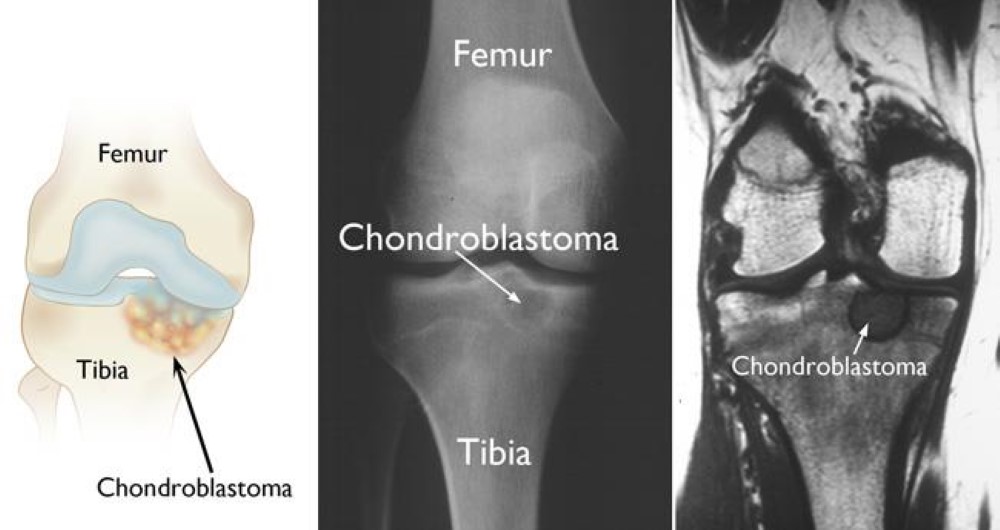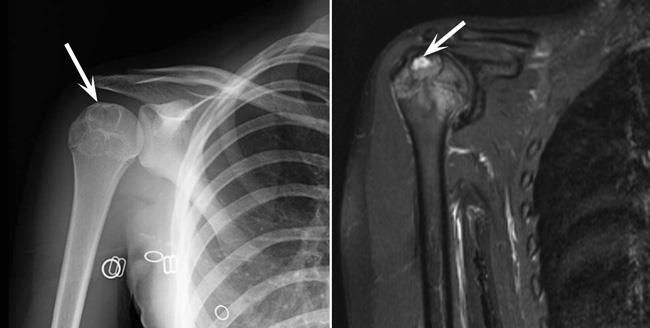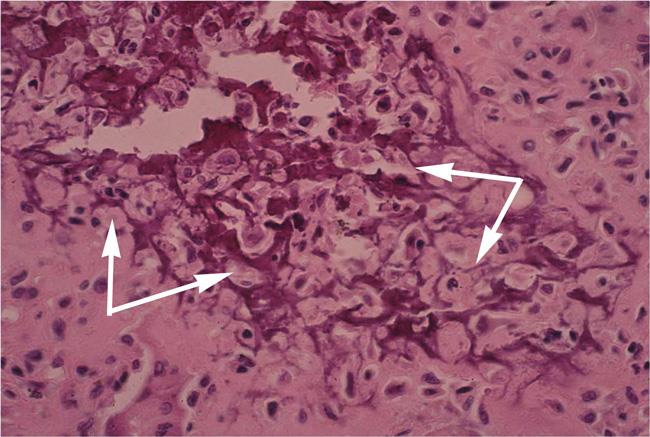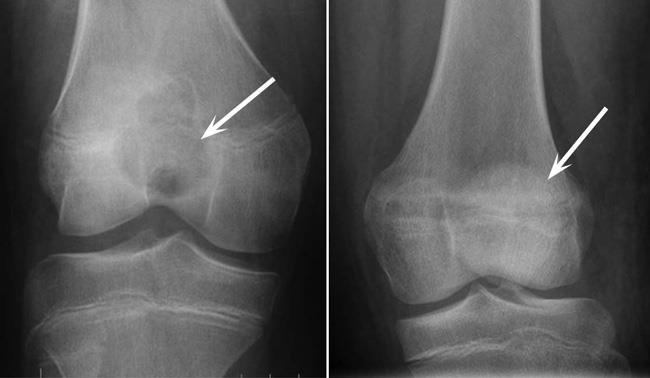Conditions Explained
Disclaimer:
This website is intended to assist with patient education and should not be used as a diagnostic, treatment or prescription service, forum or platform. Always consult your own healthcare practitioner for a more personalised and detailed opinion
Chondroblastoma
We have selected the following expert medical opinion based on its clarity, reliability and accuracy. Credits: Sourced from the website OrthoInfo, contrubited/updated by Dr Rajiv Rajani and Nathan Morrell, peer-reviewed by Dr Stuart J. Fischer and Robert H. Quinn. Please refer to your own medical practitioner for a final perspective, assessment or evaluation.
Overview
Chondroblastoma is a rare type of benign (noncancerous) tumor that grows at the ends of the body's long bones, close to the joints. Most often, the tumors develop at the ends of the femur (thighbone), tibia (shinbone), or humerus (upper arm bone). They typically occur in children and young adults, and are more common in males.
Although chondroblastomas are not cancerous, they will continue to grow if left untreated. A growing tumor can destroy the surrounding bone, making it painful to move the nearby joint. Treatment for a chondroblastoma almost always involves surgery to remove the tumor and prevent damage to the bone near the affected joint.
What is a chondroblastoma?
Most chondroblastomas are found close to the knee joint—either at the lower end of the femur (thighbone) or the upper end of the tibia (shinbone). They are also found in the shoulder at the top of the humerus (upper arm bone). This type of chondroblastoma is often referred to as a "Codman's tumor." Less common locations for chondroblastomas include the pelvis, hip, and heel.
Illustration (left), x-ray (center), and MRI scan (right) all show a chondroblastoma at the top of the (tibia) shinbone. This is a common location for the tumors to occur.

Chondroblastomas are made up of many cells that resemble fetal cartilage, which is how they got their name ("chondro" means cartilage).
Most bones start out as cartilage. As a fetus grows, this cartilage is mostly replaced by bone. In children, the ends of the body's long bones contain a small section of cartilage called a growth plate. This is the area of the bone where growth occurs. When a child is fully grown, the growth plates close, hardening into solid bone. In many cases, chondroblastomas develop around the time that the growth plates start to close.
Males are twice as likely as females to develop chondroblastomas. Eighty percent of patients are under 25 years old. The tumors are very rare, accounting for only about 1 percent of all bone tumors.
Chondroblastoma is one of the few benign bone tumors with the potential to spread, or metastasize, to the lungs. Even though a more aggressive chondroblastoma may metastasize, it is still considered a benign tumor.
Cause
The cause of chondroblastomas is not known. The tumors are thought to arise from the growth plates at the ends of the bones, near joints. However, chondroblastomas do not produce the same type of normal cartilage that makes up the growth plates or surrounds and protects the joints.
There has been no proven connection between the development of the tumors and exposure to chemicals or radiation or any particular activities.
Symptoms
Pain is the most common symptom of a chondroblastoma. Because the tumors are typically found near joints, it is joint pain that will often prompt a visit to the doctor. Over-the-counter pain medications such as acetaminophen and ibuprofen may help relieve this pain at first—but will become ineffective as the tumor grows in size.
Other signs and symptoms of a chondroblastoma may include:
- Joint stiffness
- Joint swelling
- Muscle atrophy (wasting away of the surrounding muscle from lack of use)
- A limp (when the tumor is in the lower extremities)
A chondroblastoma is usually small and contained within the bone, so patients do not normally see or feel a mass.
Doctor Examination
Physical Examination
Your doctor will talk with you about your medical history and general health and ask about your symptoms.
He or she will try to learn as much as possible about your pain. Pain at night or pain that does not go away with rest is usually more concerning. This is because pain caused by an injury will usually decrease when the injured area is not being used.
Your doctor will then examine the painful area, looking for:
- Tenderness over the bone
- Limited range of motion in the nearby joint
- Swelling around the joint
Your doctor will use imaging studies and other tests to help diagnose a chondroblastoma.
Tests
X-rays
These studies provide images of dense structures, such as bone, and are very helpful in diagnosing chondroblastomas.
Most chondroblastomas are small (1 to 4 cm), round tumors. On x-ray images, they are often surrounded by a thin rim of white bone. Some will cause the edge of the bone to push out, but rarely do the tumors extend past the bone and into the surrounding soft tissue. In about 25 to 40 percent of cases, an x-ray will show calcifications (white spots) inside the tumor.
(Left) X-ray shows a chondroblastoma at the upper end of the humerus (upper arm bone). Note the white rims outlining the tumor. (Right) An MRI scan of the same tumor.

Reproduced from DeMattos CB, Angsanuntsukh C, Arkader A, Dormans JP: Chondroblastoma and chondromyoxoid fibroma. J Am Acad Orthop Surg 2013; 21: 225-233.
Computerized tomography (CT) scans
More detailed than a plain x-ray, a CT scan can help your doctor further evaluate the tumor and plan your treatment. Calcifications inside the tumor are more likely to be visible on a CT scan.
Magnetic resonance imaging (MRI) scans
These studies provide clear images of the body's soft tissues. An MRI scan will help your doctor better see the edges of the tumor and determine whether it has expanded out of the bone and into nearby tissues. It will also show areas of inflammation that typically surround a tumor.
Biopsy
A biopsy is often necessary to confirm the diagnosis of chondroblastoma. In a biopsy, a sample of tissue is taken from the tumor and examined under a microscope.
A biopsy can be performed under local anesthesia with a needle or as a small open operation.
Under a microscope, chondroblastomas have a background that looks like cartilage and a mix of cells, some of which look like cartilage-making cells (these have nuclei that look like coffee beans). Calcifications may be seen throughout the tumor in a pattern that resembles "chicken wire."
A typical view of chondroblastoma under a microscope. The arrows indicate the characteristic "chicken wire" calcification.

Differential Diagnosis
Tests will help your doctor differentiate a chondroblastoma from other tumors that have a similar appearance, such as a giant cell tumor, enchondroma, aneurysmal bone cyst, infection of the bone (osteomyelitis), or clear-cell chondrosarcoma.
It is very important to differentiate a chondroblastoma from a more aggressive tumor like a chondrosarcoma. A pathologist (a doctor who identifies diseases by studying abnormal cells) will review the tissue sample and do special tests to help determine the diagnosis.
Treatment
Without treatment, a chondroblastoma will continue to grow and destroy the surrounding bone, so treatment is always necessary.
The goals of treatment are to:
- Remove the tumor
- Prevent damage to the bone
Surgery is always the preferred treatment for chondroblastomas; however, there are some cases in which a tumor cannot be removed safely or effectively due to its location or size. In this case, your doctor may recommend nonsurgical treatment.
Nonsurgical Treatment
Nonsurgical treatment may include:
- Radiofrequency ablation: In this procedure, the tumor is heated and destroyed with a high-frequency electrical current.
- Cryotherapy: In this procedure, the tumor is destroyed using extreme cold produced by liquid nitrogen.
Both radiofrequency ablation and cryotherapy are typically used when surgery might lead to unacceptable complications.
Surgical Treatment
Whenever possible, surgery is used to treat chondroblastomas.
Surgical treatment may include:
- Curettage: This is the procedure most commonly used to treat a chondroblastoma. In curettage, special instruments are used to scrape the tumor out of the bone. Once a chondroblastoma is curetted, it is unusual for it to return.
- Bone graft: After curettage, your doctor may fill the cavity with a bone graft to help stabilize the bone. A bone graft is taken either from a donor (allograft) or from another bone in your body (autograft)—most often, the pelvis.
Your doctor may also use a bone cement mixture to fill the hole. Sometimes, additional chemicals, such as phenol or liquid nitrogen, are placed inside the bone cavity to try to reduce the risk of recurrence.
(Left) Preoperative x-ray shows a chondroblastoma at the lower end of the femur (thighbone). (Right) X-ray shows the tumor after treatment with curettage and packing with bone cement.

Reproduced from DeMattos CB, Angsanuntsukh C, Arkader A, Dormans JP: Chrondroblastoma and chondromyoxoid fibroma. J Am Acad Orthop Surg 2013; 21: 225-233.
Resection: Depending on the location and size of the tumor, your doctor may remove the entire section of bone containing the tumor, rather than performing curettage. Metal rods or plates and screws may then be used to stabilize the bone.
In rare cases, a chondroblastoma can spread to the lungs or other organs. If the tumor spreads, surgical removal of the bone, as well as the affected area of the organ, is necessary. This will typically result in a cure.
Surgical Complications
Recurrence of the tumor is the most serious complication of surgical treatment.
Other potential complications include:
- Infection
- Rarely, fracture of the bone through the treated area
Outcomes
Your outcome after treatment will depend on a number of factors, including:
- Your age and overall health
- The size and location of the tumor
- The method of treatment
Even with successful surgery, chondroblastomas can damage the normal cartilage that surrounds and protects the joints, so some patients may develop arthritis over time.
Chondroblastomas recur in approximately 10 percent of patients. If a tumor does recur, it usually does so within a few months to a few years. For this reason, your doctor will monitor you with regular check-ups and x-rays for at least a few years. If a tumor recurs, it can be treated using the same methods. Your doctor will talk with you about all of your options.
_______________________________________________________________________________________________________________________
Are you a healthcare practitioner who enjoys patient education, interaction and communication?
If so, we invite you to criticise, contribute to or help improve our content. We find that many practicing doctors who regularly communicate with patients develop novel and often highly effective ways to convey complex medical information in a simplified, accurate and compassionate manner.
MedSquirrel is a shared knowledge, collective intelligence digital platform developed to share medical expertise between doctors and patients. We support collaboration, as opposed to competition, between all members of the healthcare profession and are striving towards the provision of peer reviewed, accurate and simplified medical information to patients. Please share your unique communication style, experience and insights with a wider audience of patients, as well as your colleagues, by contributing to our digital platform.
Your contribution will be credited to you and your name, practice and field of interest will be made visible to the world. (Contact us via the orange feed-back button on the right).